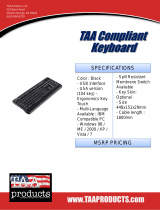
WITE32 Release Notes Version 3.11
Table of Contents
Chapter 1 New Hardware Supported in WITE32 .................................................................................................... 3
1.1 Support of Servo Revision 3 for RWA-2000 Series ....................................................................................................................................3
1.2 Comb Loader for Guzik V2002 Spinstands ................................................................................................................................................3
1.3 Ping Pong Cartridge Design for Guzik 1701A+ Spinstands .......................................................................................................................3
1.4 Micro Actuator Support for Guzik V2002 Spinstands .................................................................................................................................4
1.4.1 Hardware Compatibility.................................................................................................................................................................4
1.4.2 Micro Actuator Tests .....................................................................................................................................................................4
1.5 Head Amplifiers ..........................................................................................................................................................................................5
1.6 Head Stacks ...............................................................................................................................................................................................5
1.7 Support of Head Amplifier Multiplexer ........................................................................................................................................................5
Chapter 2 WITE32 Modifications............................................................................................................................. 6
2.1 New System Erase and System Band Erase Configuration.......................................................................................................................6
2.1.1 Using System Erase In WITE32 Tests..........................................................................................................................................8
2.1.2 Tests Without Erase Configuration ...............................................................................................................................................8
2.1.3 Tests With Erase Configuration ....................................................................................................................................................8
2.1.4 Tests With Band Erase Configuration.........................................................................................................................................10
2.1.5 Tests With Erase Preconditioning...............................................................................................................................................12
2.2 New Adjacent Track Interference Module (WATI) ....................................................................................................................................13
2.3 Spinstands and Servo...............................................................................................................................................................................13
2.3.1 New Servo Control Dialog Box ...................................................................................................................................................13
2.3.2 V2002 Product Parameters Dialog Box Modifications ................................................................................................................13
2.3.3 XY Alignment Test ......................................................................................................................................................................18
2.4 New Installation Procedure For Guzik PCI Boards...................................................................................................................................18
2.5 The Write With Retries Operation.............................................................................................................................................................19
2.6 TAA Calibration Through Programmable Differentiator............................................................................................................................20
2.7 Error / Warning Report Modification .........................................................................................................................................................20
2.8 Head Selection in the WITE32 Engineering Dashboard...........................................................................................................................21
2.9 Miscellaneous ...........................................................................................................................................................................................22
Chapter 3 Fixed Bugs............................................................................................................................................. 24
3.1 V2002 Spinstand ......................................................................................................................................................................................24
3.2 Other Spinstands and Servo.....................................................................................................................................................................25
3.3 Analog Front End......................................................................................................................................................................................25
3.4 Tests and Measurements .........................................................................................................................................................................26
3.5 Miscellaneous ...........................................................................................................................................................................................27
Chapter 4 Support of Microsoft Windows XP Operating System ...................................................................... 28
Chapter 5 Known Issues ........................................................................................................................................ 29
Guzik Technical Enterprises 2




















